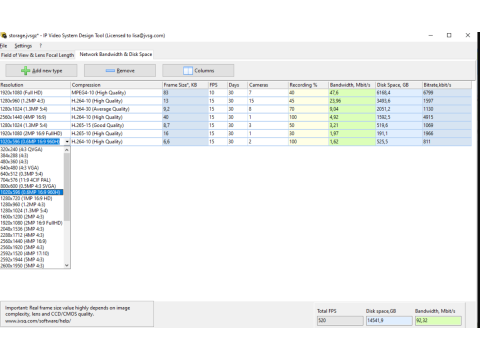How to Calculate Key Parameters for a Video Surveillance System
Designing an effective video surveillance system requires careful calculation of several technical parameters to ensure optimal performance and reliability. This guide outlines the critical calculations needed for both analog and IP systems.
1. Calculating the Number of Cameras
The first step is determining the number of cameras required, based on:
- Zone coverage: Each camera's field of view (determined by its focal length).
- Detail level needed: Tasks like identification or general monitoring require different resolutions and placements.
For example, wider angles require fewer cameras but may compromise image detail.
2. Calculating Camera Coverage
To determine the optimal focal length and angle of view:
- Define the surveillance area dimensions.
- Consider the required resolution and distance to identify objects.
For critical zones like entrances, higher resolution and narrower focus are essential for identification tasks.
3. Power Supply Calculation
After selecting cameras, calculate the total power supply requirements:
- Sum the power ratings of all cameras.
- Add an additional 20% as a safety margin.
Ensure that selected power supplies match the cameras' operating voltage and provide sufficient amperage.
4. Selecting a Video Recorder
The recorder must support:
- Number of channels: Equal to the total number of cameras.
- Recording resolution: At least as high as the cameras' resolution.
- Recording speed: Match the required frames per second (fps) for smooth playback.
5. Calculating Storage Requirements
Storage capacity depends on several factors:
- Number of cameras.
- Recording resolution and fps.
- Compression format (e.g., H.264 or H.265).
- Desired storage duration: Define how many days of footage you need to keep.
General Formula:
Example:
For four 1080p cameras recording at 4 Mbps, 24/7 for 30 days:
6. Bandwidth Calculation for IP Cameras
IP cameras require bandwidth calculations to ensure smooth data transmission:
- Total bandwidth = Camera bitrate × Number of cameras.
- Ensure the selected network switch and cabling (e.g., Cat 5e) support the required throughput.
For a network with 10 cameras streaming at 6 Mbps each:
7. Using PoE for IP Cameras
If using Power over Ethernet (PoE):
- Confirm the PoE switch’s power output meets the total power needs of all connected cameras.
- Ensure cable lengths do not exceed 328 feet (100 meters) without additional hardware.
Considerations for Large Systems
For larger projects, advanced calculations may be required, including:
- Configuring RAID storage systems for redundancy.
- Integrating IP systems into existing local networks.
- Balancing bandwidth usage across multiple network switches.
Conclusion
Accurate calculations ensure that a video surveillance system is cost-effective, reliable, and capable of meeting security needs. Whether for small residential setups or large-scale commercial installations, understanding these parameters is key to success.

